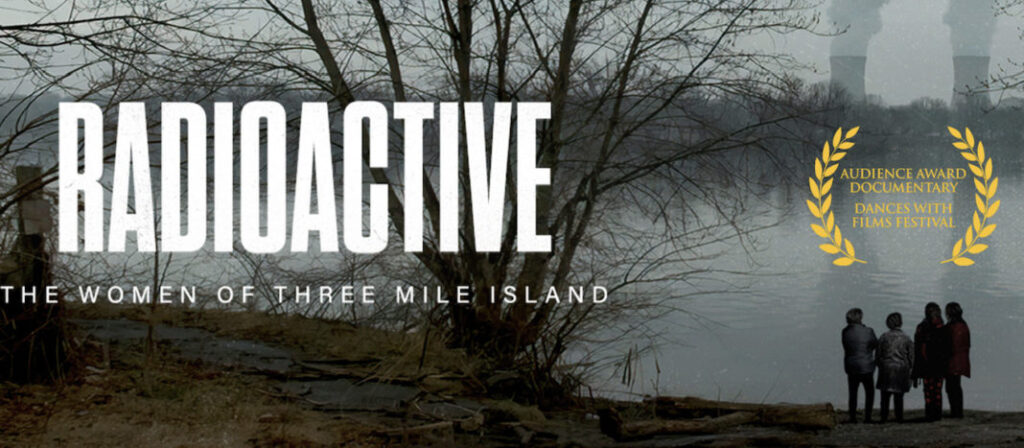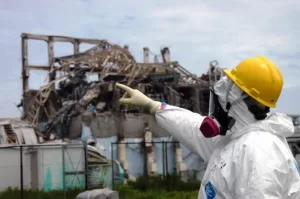Radioactive: The Women of Three Mile Island is the title of a newly-released documentary feature film directed, written and produced by award-winning filmmaker Heidi Hutner, a professor of environmental humanities at Stony Brook University, a “flagship” school of the State University of New York.
With greatly compelling facts and interviews, she and her also highly talented production team have put together a masterpiece of a documentary film.
It connects the proverbial dots of the 1979 Three Mile Island nuclear plant disaster—doing so brilliantly.
The documentary has already received many film awards and has had a screening in recent months in New York City—winning the “Audience Award for Best Documentary” at the Dances With Films Festival—and Harrisburg, Pennsylvania; Sarasota, Florida; Dubuque, Iowa; Long Island, New York; First Frame International Film Festival in New York City; the Environmental Film Festival in Washington D.C., and is soon the featured film at Kat Kramer’s #SHEROESForChange Film Festival in Los Angeles and the Cinequest Film Festival in San Jose, California, as well as the Uranium Film Festival in Rio de Janeiro in Brazil. And there will be tours across the U.S.
Resident after resident of the area around Three Mile Island is interviewed and tells of widespread cancer that has ensued in the years that have followed the accident—a cancer rate far beyond what would be normal. Accounts shared in the documentary are heartbreaking.
A whistleblower who had worked at the nuclear plant tells Hutner of the deliberate and comprehensive attempt by General Public Utilities, which owned TMI, to cover up the gravity of the accident and its radioactive releases, especially of cancer-causing Iodine-131 and Xenon 133.
An attorney, Lynne Bernabei, involved in litigation in the wake of the accident, says the Three Mile Island “cover-up was one of the biggest cover-ups in history.” Meanwhile, the U.S. Nuclear Regulatory Commission which is “supposed to protect the public” has then and since been just “interested in is promoting the [nuclear] industry. This is corrupt,” says attorney Joanne Doroshow, now a professor at New York Law School and director of the Center for Justice & Democracy. Many examples of this are presented.
The documentary’s focus on women includes women being far more at risk to the effects of radioactivity than men. Mary Olson, a biologist, founder, and director of the Gender & Radiation Impact Project, says in the film that those setting radiation standards in the U.S. from the onset of nuclear technology in 1942, based impacts on a “25 to 30 years-old” male “defined as Caucasian.” She said, “It has come to be known as the ‘Reference Man.” However, Olson cites research findings that “radiation is 10 times more harmful to young females” and “50 percent more harmful to a “comparable female” than it is to “Reference Man” who is “more resistant” to radioactivity than a woman.
There’s the scientist Dr. Aaron Datesman, who is now pursuing a major chromosomal study regarding the impact of the disaster on the health of people in the area, and how people have been harmed despite the denials of the nuclear industry. This study is based on his recent ground-breaking work, “Radiological Shot Noise,” in Nature.
And more and more.
After the screening of the documentary at the Cinema Arts Centre in Huntington, Long Island, the showing I attended, there was a panel discussion involving Hutner, four women featured in the documentary, and its editor Simeon Hutner, who is also a producer.
The discussion was moderated by Kelly McMasters, author of the memoir, Welcome to Shirley, A Memoir of an Atomic Town, and a professor at Hofstra University on Long Island. McMasters in her book attributes wide-ranging cancer in her Shirley hometown on Long Island to radioactive releases from the three nuclear reactors that operated at the adjacent Brookhaven National Laboratory, reactors that are now shut down.
From the audience, Catherine Skopic of Manhattan, who journeyed to Long Island for the premiere of the documentary in Huntington, said the film “is going to make waves.” She related the link between the TMI accident and contemporary nuclear issues. These included the plan by Holtec International, now the owner of the closed Indian Point nuclear power plants 25 miles north of the city, to “dump a million gallons of radioactive water” into the Hudson River from which “seven communities get their drinking water,” and similar dumping planned in coming months by the Tokyo Electric Power Company from its 2011 accident-struck Fukushima Daichi nuclear power plants into the Pacific Ocean.
Hutner, in speaking about the focus on women in Radioactivity: The Women of Three Mile Island, explains: “Following health and safety disasters, it is often women on the ground fighting back, and over and over throughout nuclear history, these women are gaslighted, silenced, called hysterical and ‘radiophobic.’ The result of such silencing: we lose significant information about nuclear history, science, and health.”
Hutner goes on: “What I have dug up after over 20 years of ecofeminist research is shocking—Dr. Alice Stewart’s research on the danger of X-rays to fetuses in the womb; Rachel Carson’s writing about radiation and bioaccumulation; Dr. Helen Caldicott’s warnings about the dangers of nuclear weapons and her peace and vital medical health advocacy as a physician (she has been attacked mercilessly and unfairly by male critics on sexist grounds); Mary Olson’s study of the alarming danger of radiation to girls and women, Leona Morgan’s decolonization activism to protect indigenous communities from uranium extraction and poisoning, and the dumping radioactive waste on native lands; poet activist Kathy Jetnil-Kijner’s story-telling about the suffering of women miscarrying in the Marshall Islands after the 67 nuclear test-bombing by the U.S. There are endless stories such as these.”
“By erasing such women’s voices, by gaslighting these women, men have erased significant human stories, science, research,” says Hutner. “This is a classic sexist maneuver. Call women and those who speak up about the dangers of nuclear technology as radiophobic, hysterical, and incapable of understanding science. As the women in Radioactivity explain, when they spoke at the Nuclear Regulatory Hearings and meetings, asking intelligent questions about the verity of the nuclear company’s and NRC’s claims, and armed with detailed information regarding their corruption and cover-ups—what really happened—the women were laughed at, mocked, told to ‘go home and bake cookies.’”
“That’s why we made Radioactive. The public needs to know and understand how they are being lied to, how key aspects of nuclear disasters and radiation impacts have been swept under the rug. And at what cost. This is life and death. An so we focus on buried women stories, and in subsequent film projects we hope to make as part of a series, we will bring in the silenced voices of black, brown, and women’s indigenous groups impacted unequally by nuclear disasters.”
She adds: “The film could not come at a more important time for a number of reasons. With nuclear power being discussed in some circles as an ‘answer’ to our climate crisis, we believe anyone seeing this film will walk away with the unmistakable conclusion that nuclear power must be off the table. TMI is one of a long list of environmental disasters and cover-ups that have caused serious harm to surrounding communities, which will last decades. It was and continues to be the lesson of what happens when a corporation and industry lacking integrity, regulated by an agency completely captured by that industry, is put in charge of people’s lives. TMI happened 44 years ago. But when it comes to systems meant to protect the public’s health and safety from nuclear hazards, nothing has changed and in fact, has only gotten worse.”
Comments about the documentary include:
Edward Moran, in Cinema Daily US, calls it “a compelling and significant documentary in the grand tradition of such trailblazing women filmmakers as Kimberlee Acquaro, Christine Choy, and Barbara Koppel…This is a film that should be rated in supernovas, not stars.”
It “is a stunning and vital award-winning film,” says Jon Bowermaster, himself an award-winning filmmaker for National Geographic. “It asks the important question: should we or shouldn’t we with nuclear energy?…Heidi Hutner presents this question with solid research on nuclear history and science, and she offers heartfelt compassion for the women and their families who lived through the meltdown at Three Mile Island. The film is a must-see for anyone who cares about our energy future and our planet.”
Dave Chameides, a two-time Emmy award-winning director, says: “Most of America would be shocked to know the true story of the meltdown at Three Mile Island. Far fewer would ever want the thing in their backyard. Prof. Hutner takes us there and meets the people who have no choice but to call the worst nuclear meltdown in U.S. history their neighbor. This is a stunning film that everyone should see. The filmmakers have created a personal story that will and should resonate with everyone.”
The documentary website is: https://radioactivethefilm.com/. There you will find listings for upcoming screenings.
Hutner says: “We made Radioactive: The Women of Three Mile Island because the issue of nuclear dangers has ‘died’ as an important cause. It was once a global movement. Front page news. One million people marched in Central Park and so did millions around the world. The big screen popped with blockbusters on the topic. Today: few know or care about nuclear dangers—historical or in the present.”
“Sadly,” Hutner continues, “younger folks are taught nothing in school about nuclear history except a brief lesson (if they are taught anything) on how great nuclear energy is. My students are shocked and aghast at what they learn in my classes (in-depth history and present information). They’ve heard a little bit about Hiroshima and Nagasaki, and they have heard of Chernobyl (barely). They haven’t a clue about anything else. They don’t know what nuclear power is or how it functions. They don’t think about nuclear weapons and the potential for nuclear obliteration.”
“The nuclear industry has won its plan to silence this history and science. They’ve invested heavily in painting a pretty picture, erasing facts, and denigrating concerned citizens, particularly women, as I have explained. There’s no recognition of the great harm done to fetuses, babies, children—especially girl children. There’s a complete disregard for the poisoning of communities of color. Dr. Robert Bullard, the father of the environmental justice movement, and Winona LaDuke, a leading indigenous ecofeminist activist, call this environmental racism.”
“Pronuclear films by Bill Gates, Oliver Stone, Robert Stone, leave out essential information — real experiences of real people who live next to reactors, live with and in disaster zones and highly toxic areas,” Hutner notes. “From what I can see—these guys (note their gender and color) have not spoken with or met the people who live with high rates of cancer and multigenerational cancers in disaster locations. They don’t visit and spend time in these communities. Childhood cancers. Heart disease. Infertility. Deformed babies. Miscarriages. Infertility. On and on.”
“These pro-nuke guys,” Hutner continues, “do not address the science that shows the dangers of radiation exposures or the future of inevitable meltdowns. They blackball this science. They don’t discuss radioactive waste—where and how it’s maintained (poorly—putting all life at risk for thousands of years). And the location of the waste? Mostly indigenous lands and always poorly stored. Waste right on-site at the nuclear facilities, leaving communities located next to and near power plants at risk for thousands of years. They dump nuclear waste in waterways.”
“This little film: We are the little engine that could. We are fighting a mighty powerful force. Money. The military complex. Power. Patriarchy,” Hutner says.
“Radioactive: The Women of Three Mile Island—I have researched this subject for 20 years. I have worked closely with world-class scientists, doctors, hard-working and deeply knowledgeable activists, and attorneys. I have interviewed untold numbers of people on the ground at assorted disaster locations—spent years in these communities.”
“This film is for all of our children, great and great and great grands- —-and on….Meet our four magnificent mothers: Linda Hoagland Braasch, Beth Drazba, Joyce Corradi, and Paula Kinney. They lived five miles from the meltdown. These were ‘Leave it to Beaver’ mothers who loved their children so much they had to literally leave their kitchens to become activists and fight the US Regulatory Commission and the nuclear industry—criminals (literally) who were covering up the truth. The moms tell me they didn’t want to fight this battle, but they had to, because the government wasn’t protecting them or telling the truth. Someone had to protect their children.”
“Meet the courageous lawyers Joanne Doroshow and Lynne Bernabei, who as young women defended this community and took their case all the way to the Supreme Court.
Meet the heroic Michele LeFever Quinn, a just out of college reporter who put her life on the line as she reported on the ground during the meltdown.”
A great woman filmmaker is born. I can’t wait to see what she does next.
[Karl Grossman, professor of journalism at State University of New York/College at Old Westbury, and is the author of the book, ‘The Wrong Stuff: The Space’s Program’s Nuclear Threat to Our Planet’, and the Beyond Nuclear handbook, ‘The U.S. Space Force and the dangers of nuclear power and nuclear war in space’. He is also an associate of the media watch group Fairness and Accuracy in Reporting (FAIR). Courtesy: CounterPunch.]




